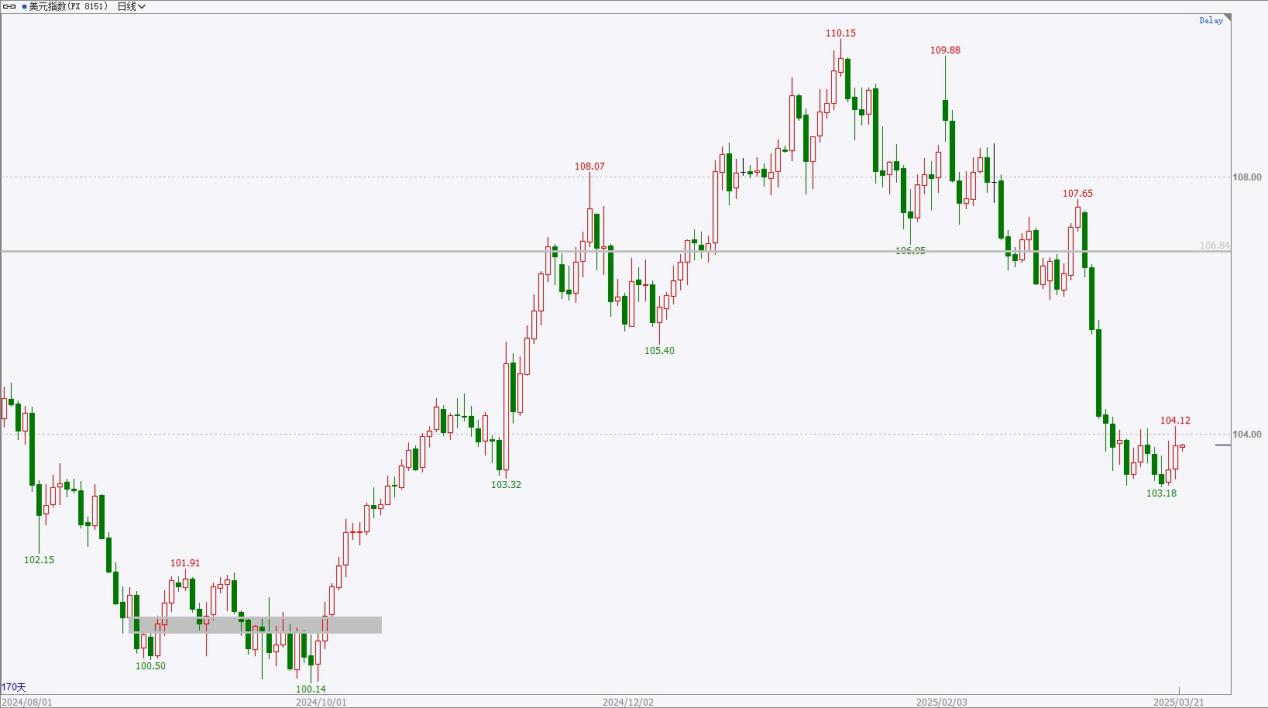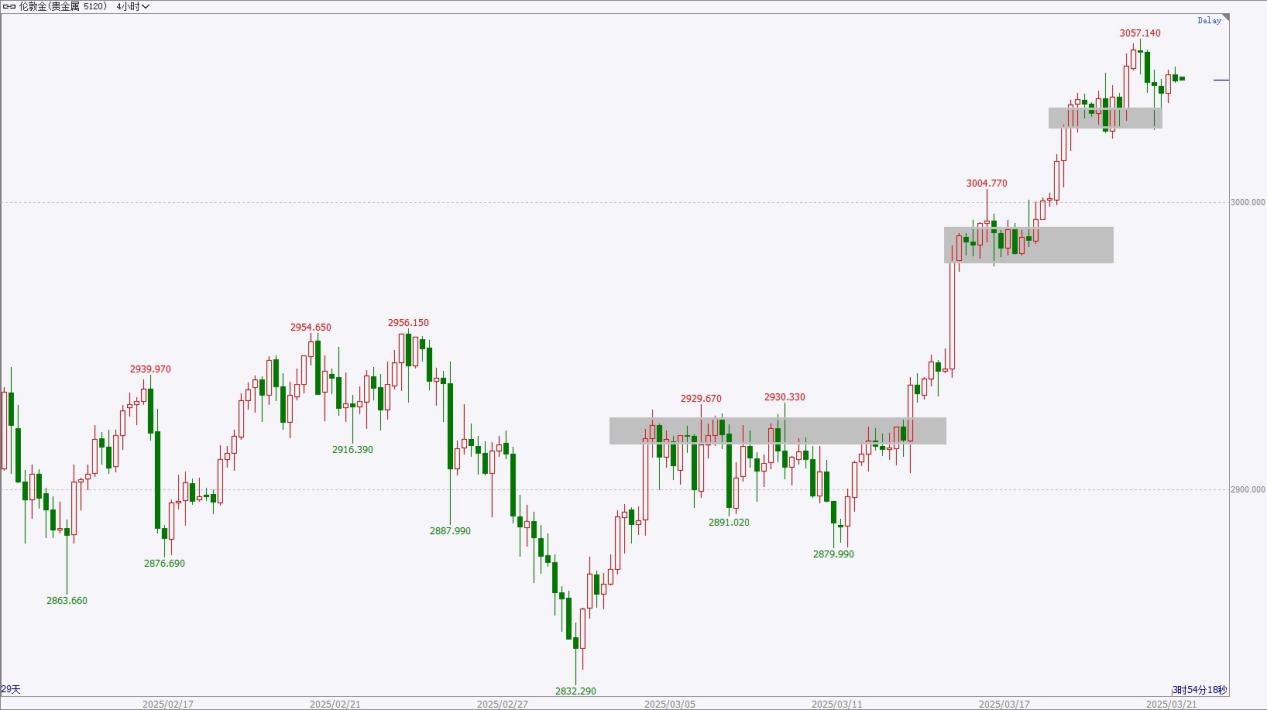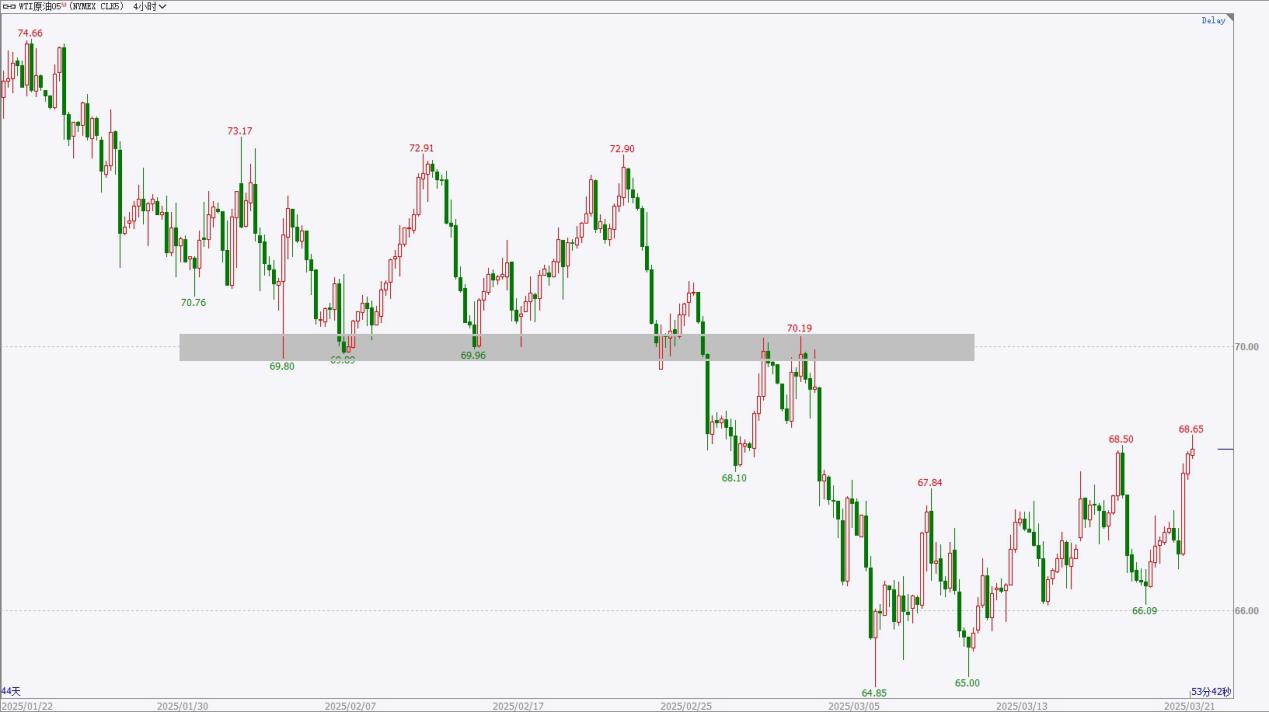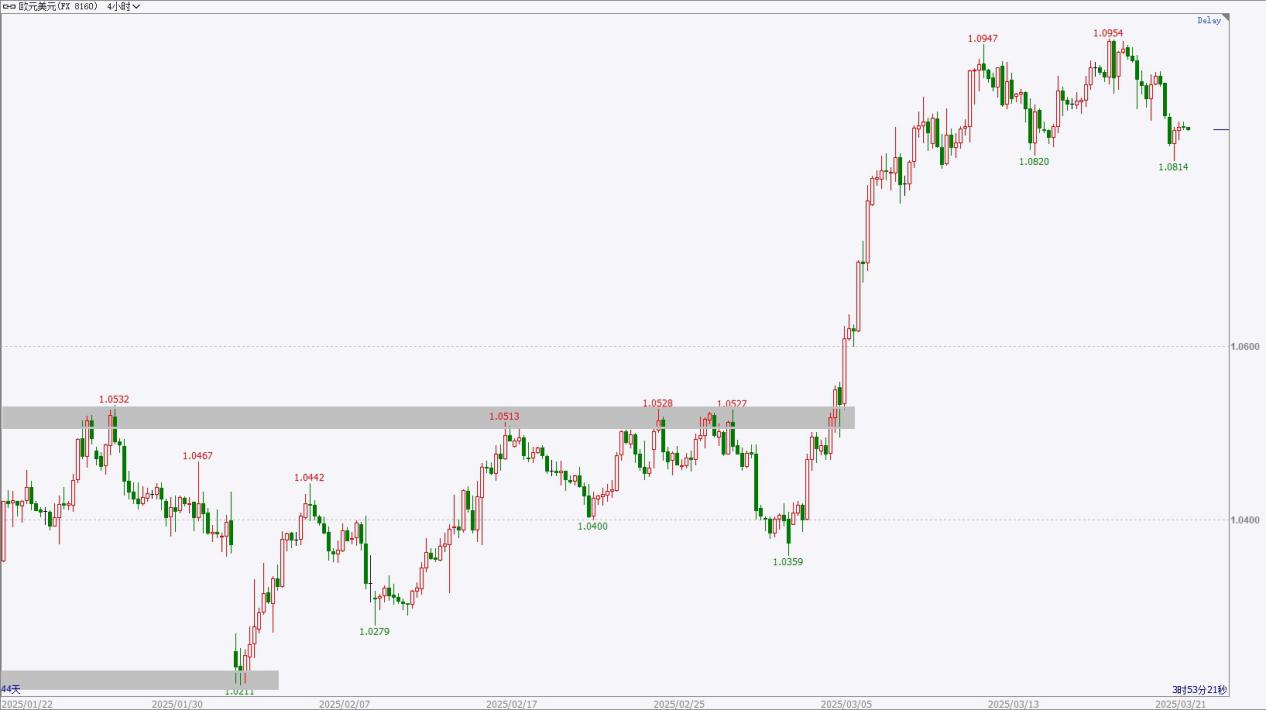|
Time
|
Data and Events
|
Importance
|
|
07:30
|
Japan’s February Core CPI Year-on-Year
|
★★★
|
|
08:01
|
UK’s March Gfk Consumer Confidence Index
|
★★★
|
|
17:00
|
Eurozone’s January Seasonally Adjusted Current Account
|
★★★
|
|
19:00
|
UK’s March CBI Industrial Orders Balance
|
★★★
|
|
UK’s March CBI Retail Sales Balance
|
★★★
|
|
20:30
|
Canada’s January Retail Sales Month-on-Month
|
★★★
|
|
21:05
|
FOMC Permanent Voting Member Williams gives a speech
|
★★★
|
|
23:00
|
Eurozone’s March Consumer Confidence Index Preliminary Value
|
★★★
|
|
Variety
|
Viewpoint
|
Support Range
|
Resistance Range
|
|
US Dollar Index
|
Short-term Fluctuation
|
101-102
|
106-107
|
|
Gold
|
Fluctuation with a Bullish Bias
|
2980-3000
|
3080-3100
|
|
Crude Oil
|
Short-term Fluctuation
|
65-66
|
70-71
|
|
Euro
|
Fluctuation with a Bullish Bias
|
1.0750-1.0800
|
1.0950-1.1000
|
*Pre-market views are time-sensitive and limited, are subjective forecasts, only for reference and learning purposes, do not constitute investment advice, and operation risks are self-borne. Investment has risks; trading requires caution.
Fundamental Analysis:
In the March FOMC meeting, interest rates were kept unchanged, the labor market remains stable, inflation expectations for this and next year were raised, and GDP growth projections for the next three years were lowered. Starting in April, the pace of balance sheet reduction will slow down, and there is uncertainty in tariff policies. In February, non-farm data showed a net increase of 151,000 jobs, slightly below expectations, while the unemployment rate slightly increased, indicating a slight easing in the labor market. The non-seasonally adjusted CPI year-on-year for February recorded 2.8%, slightly below the previous value and expectations. The core PCE price index for January fell slightly, in line with expectations.
Technical Analysis:

The US dollar index rebounded slightly yesterday, with a small cycle peaking then retreating, facing selling pressure above. Short-term downtrends show signs of slowing, and a fluctuating structure has emerged, focusing on whether a stabilization signal will appear, which could lead the market to rebound. Overall, there are signs of weakening after a high-level stagnation on the daily chart, with a potential continuation of a weak retracement in the short term. The resistance area is near 106-107, while the support area is around 101-102.
Viewpoint: Short-term fluctuation, signs of consolidation in small cycles, focus on whether stabilization signals will emerge.
*Pre-market views are time-sensitive and limited, are subjective forecasts, only for reference and learning purposes, do not constitute investment advice, and operation risks are self-borne. Investment has risks; trading requires caution.
Fundamental Analysis:
The ongoing worsening of Middle Eastern geopolitical conflicts, combined with a soothing situation in Eastern Europe, introduces uncertainty. The European Central Bank’s March rate decision saw a fifth consecutive 25 basis point rate cut, with steady inflation progress and downside risks to economic growth. In the March FOMC rate decision, rates were kept unchanged amid a stable labor market, while GDP growth projections were lowered and balance sheet reduction will slow down. In February, the US non-farm data showed some easing, with the net increase in jobs slightly below expectations and unemployment rising slightly to 4.1%; the non-seasonally adjusted CPI year-on-year for February recorded 2.8%, marginally below expectations.
Technical Analysis:

Gold prices saw a slight pullback yesterday, with a small cycle fluctuating back and forth, not showing any signs of weakness yet, currently at a relatively high position. If there are long positions, consider reducing holdings to take profits at high points. In the short term, it may maintain a bullish trend, and the strategy should focus on re-entering at lower points. In the longer term, the upward structure is intact, and the daily chart shows a fluctuating rise, indicating strength. Resistance levels may be around 3080-3100, while minor support levels are around 2980-3000.
Viewpoint: Fluctuating with a bullish bias; reduce long positions at high points, primarily focus on re-entering at lower points.
*Pre-market views are time-sensitive and limited, are subjective forecasts, only for reference and learning purposes, do not constitute investment advice, and operation risks are self-borne. Investment has risks; trading requires caution.
Fundamental Analysis:
The March EIA monthly report maintains the crude oil price forecast for 2025 and slightly raises the global crude oil demand growth expectation for 2026; the OPEC monthly report keeps the global crude oil demand growth expectations for this year and next unchanged; the IEA monthly report slightly lowers the global oil demand growth expectations for 2025. In early February, the OPEC+ meeting adhered to the previous oil production agreement, with the committee agreeing to gradually increase oil production starting April 1, in line with previous plans. EIA crude oil inventories have slightly increased, which may put pressure on oil prices, with attention to changes in the supply-demand structure.
Technical Analysis:

US crude oil prices surged in the night session, with a rebound in the short cycle. The current price is relatively low, with some distance from the resistance level, indicating potential for further rebounds. In the short term, there may be opportunities to buy on the dip; profits should be taken in a timely manner. Overall, the crude oil price is fluctuating at a low level without signs of stabilization. The upper resistance area is around 70-71, and the lower support area is around 65-66.
Viewpoint: Short-term fluctuations are expected near the support area, with a possibility of a rebound.
*Pre-market views are time-sensitive and limited, are subjective forecasts, only for reference and learning purposes, do not constitute investment advice, and operation risks are self-borne. Investment has risks; trading requires caution.
Fundamental Analysis:
The European Central Bank’s interest rate decision in early March resulted in a 25 basis point rate cut for the fifth consecutive time, with inflation regressing steadily and a slight downward adjustment of GDP growth forecasts for this year and next, indicating a downwards risk to economic growth, with tariffs potentially causing negative impacts. In March, the Federal Reserve maintained its interest rate decision, raised inflation expectations, and lowered GDP growth forecasts, indicating a slowdown in the balance sheet reduction pace. The US non-farm employment data for February showed slight easing, with new job numbers slightly below expectations and the unemployment rate rising mildly to 4.1%. The manufacturing PMI in the Eurozone showed little change.
Technical Analysis:

The Euro price slightly retreated yesterday, indicating a short-term consolidation with signs of slowing bullish momentum, but no weakening signals have appeared yet. If there are long positions, one should consider taking profits on highs and be wary of entering a short-term adjustment phase. Overall, the price is at a relatively low level, with a daily fluctuation structure that might indicate significant stabilization signals. The upper resistance area is around 1.0950-1.1000, and the lower minor support area is around 1.0750-1.0800.
Viewpoint: Fluctuations leaning towards strength; take profits on highs for long positions, and be cautious of short-term adjustments.
*Pre-market views are time-sensitive and limited, are subjective forecasts, only for reference and learning purposes, do not constitute investment advice, and operation risks are self-borne. Investment has risks; trading requires caution.


Daily Reviews
Our award-winning team of analysts provides keen and insightful technical and fundamental analysis to understand daily market news and investment trading opportunities
HTFX Daily Forex Commentary 0321
Time
Data and Events
Importance
07:30
Japan’s February Core CPI Year-on-Year
★★★
08:01
UK’s March Gfk Consumer Confidence Index
★★★
17:00
Eurozone’s January Seasonally Adjusted Current Account
★★★
19:00
UK’s March CBI Industrial Orders Balance
★★★
UK’s March CBI Retail Sales Balance
★★★
20:30
Canada’s January Retail Sales Month-on-Month
★★★
21:05
FOMC Permanent Voting Member Williams gives a speech
★★★
23:00
Eurozone’s March Consumer Confidence Index Preliminary Value
★★★
Variety
Viewpoint
Support Range
Resistance Range
US Dollar Index
Short-term Fluctuation
101-102
106-107
Gold
Fluctuation with a Bullish Bias
2980-3000
3080-3100
Crude Oil
Short-term Fluctuation
65-66
70-71
Euro
Fluctuation with a Bullish Bias
1.0750-1.0800
1.0950-1.1000
*Pre-market views are time-sensitive and limited, are subjective forecasts, only for reference and learning purposes, do not constitute investment advice, and operation risks are self-borne. Investment has risks; trading requires caution.
Fundamental Analysis:
In the March FOMC meeting, interest rates were kept unchanged, the labor market remains stable, inflation expectations for this and next year were raised, and GDP growth projections for the next three years were lowered. Starting in April, the pace of balance sheet reduction will slow down, and there is uncertainty in tariff policies. In February, non-farm data showed a net increase of 151,000 jobs, slightly below expectations, while the unemployment rate slightly increased, indicating a slight easing in the labor market. The non-seasonally adjusted CPI year-on-year for February recorded 2.8%, slightly below the previous value and expectations. The core PCE price index for January fell slightly, in line with expectations.
Technical Analysis:
The US dollar index rebounded slightly yesterday, with a small cycle peaking then retreating, facing selling pressure above. Short-term downtrends show signs of slowing, and a fluctuating structure has emerged, focusing on whether a stabilization signal will appear, which could lead the market to rebound. Overall, there are signs of weakening after a high-level stagnation on the daily chart, with a potential continuation of a weak retracement in the short term. The resistance area is near 106-107, while the support area is around 101-102.
Viewpoint: Short-term fluctuation, signs of consolidation in small cycles, focus on whether stabilization signals will emerge.
*Pre-market views are time-sensitive and limited, are subjective forecasts, only for reference and learning purposes, do not constitute investment advice, and operation risks are self-borne. Investment has risks; trading requires caution.
Fundamental Analysis:
The ongoing worsening of Middle Eastern geopolitical conflicts, combined with a soothing situation in Eastern Europe, introduces uncertainty. The European Central Bank’s March rate decision saw a fifth consecutive 25 basis point rate cut, with steady inflation progress and downside risks to economic growth. In the March FOMC rate decision, rates were kept unchanged amid a stable labor market, while GDP growth projections were lowered and balance sheet reduction will slow down. In February, the US non-farm data showed some easing, with the net increase in jobs slightly below expectations and unemployment rising slightly to 4.1%; the non-seasonally adjusted CPI year-on-year for February recorded 2.8%, marginally below expectations.
Technical Analysis:
Gold prices saw a slight pullback yesterday, with a small cycle fluctuating back and forth, not showing any signs of weakness yet, currently at a relatively high position. If there are long positions, consider reducing holdings to take profits at high points. In the short term, it may maintain a bullish trend, and the strategy should focus on re-entering at lower points. In the longer term, the upward structure is intact, and the daily chart shows a fluctuating rise, indicating strength. Resistance levels may be around 3080-3100, while minor support levels are around 2980-3000.
Viewpoint: Fluctuating with a bullish bias; reduce long positions at high points, primarily focus on re-entering at lower points.
*Pre-market views are time-sensitive and limited, are subjective forecasts, only for reference and learning purposes, do not constitute investment advice, and operation risks are self-borne. Investment has risks; trading requires caution.
Fundamental Analysis:
The March EIA monthly report maintains the crude oil price forecast for 2025 and slightly raises the global crude oil demand growth expectation for 2026; the OPEC monthly report keeps the global crude oil demand growth expectations for this year and next unchanged; the IEA monthly report slightly lowers the global oil demand growth expectations for 2025. In early February, the OPEC+ meeting adhered to the previous oil production agreement, with the committee agreeing to gradually increase oil production starting April 1, in line with previous plans. EIA crude oil inventories have slightly increased, which may put pressure on oil prices, with attention to changes in the supply-demand structure.
Technical Analysis:
US crude oil prices surged in the night session, with a rebound in the short cycle. The current price is relatively low, with some distance from the resistance level, indicating potential for further rebounds. In the short term, there may be opportunities to buy on the dip; profits should be taken in a timely manner. Overall, the crude oil price is fluctuating at a low level without signs of stabilization. The upper resistance area is around 70-71, and the lower support area is around 65-66.
Viewpoint: Short-term fluctuations are expected near the support area, with a possibility of a rebound.
*Pre-market views are time-sensitive and limited, are subjective forecasts, only for reference and learning purposes, do not constitute investment advice, and operation risks are self-borne. Investment has risks; trading requires caution.
Fundamental Analysis:
The European Central Bank’s interest rate decision in early March resulted in a 25 basis point rate cut for the fifth consecutive time, with inflation regressing steadily and a slight downward adjustment of GDP growth forecasts for this year and next, indicating a downwards risk to economic growth, with tariffs potentially causing negative impacts. In March, the Federal Reserve maintained its interest rate decision, raised inflation expectations, and lowered GDP growth forecasts, indicating a slowdown in the balance sheet reduction pace. The US non-farm employment data for February showed slight easing, with new job numbers slightly below expectations and the unemployment rate rising mildly to 4.1%. The manufacturing PMI in the Eurozone showed little change.
Technical Analysis:
The Euro price slightly retreated yesterday, indicating a short-term consolidation with signs of slowing bullish momentum, but no weakening signals have appeared yet. If there are long positions, one should consider taking profits on highs and be wary of entering a short-term adjustment phase. Overall, the price is at a relatively low level, with a daily fluctuation structure that might indicate significant stabilization signals. The upper resistance area is around 1.0950-1.1000, and the lower minor support area is around 1.0750-1.0800.
Viewpoint: Fluctuations leaning towards strength; take profits on highs for long positions, and be cautious of short-term adjustments.
*Pre-market views are time-sensitive and limited, are subjective forecasts, only for reference and learning purposes, do not constitute investment advice, and operation risks are self-borne. Investment has risks; trading requires caution.
Latest Reviews
HTFX Daily Forex Commentary 0819
HTFX Daily Forex Commentary 0815
HTFX Daily Forex Commentary 0812
HTFX Daily Forex Commentary 0811
Choose a Trusted Broker for Trading
Over 300 employees worldwide, more than 1,000 products, top-tier liquidity